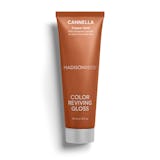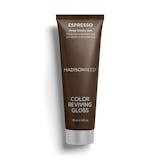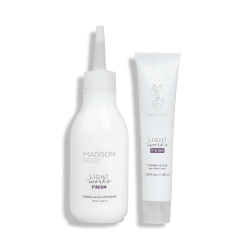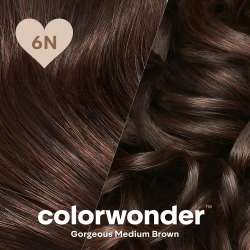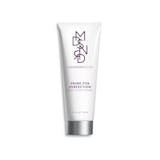Terms like demi gloss, demi glaze, and demi dye are often thrown around amongst colorists and clients. At first glance, they might seem like completely different products or concepts, but in reality, these terms are often used interchangeably within the world of hair color and the verbiage color brands or colorists use. Each one might be used differently to give a different effect and serve a distinct purpose to create the color result you are looking for. Let's dive into the details, compare demi gloss vs. demi glaze vs. demi dye, and clear up the confusion.
Rachael Thomas | November 06, 2024
Demi Gloss vs. Demi Glaze vs. Demi Dye

Image by Madison Reed
What Is Demi?
First off, what does demi mean? Before we get into gloss vs. glaze vs. dye it's important to understand what demi means. Demi-permanent color is a category of hair color that lives between permanent and semi-permanent color.
Demi-permanent color does not permanently alter the hair and therefore does not last as long as permanent color. Demi-permanent color uses a lower level of hydrogen peroxide which means it typically cannot lighten the hair or fully cover gray hair. It can blend gray but not provide full gray coverage like permanent color does.
On the other hand, demi-permanent color lasts longer than semi-permanent color, as it penetrates the cuticle layer of the hair whereas semi only sits on the outer layer. Semi-permanent color does not provide any gray blending whereas demi-permanent does.
Understanding Demi Gloss vs. Demi Glaze
Now that you know what "demi" means, let's talk about demi gloss vs. glaze.
The word gloss or glaze typically refers to the overall effect and result that the color provides. Both of these products typically have some form of color pigment to them. However, some may be more sheer, and some may be slightly more pigmented depending on the amount of color payoff you are looking to achieve.
The term gloss may be used more frequently when the focus is increasing shine and/or refreshing faded color. Now, we do want to mention that some “glosses” on the market may come in semi-permanent form, not just demi-permanent. This is where using these terms interchangeably comes into play and it all comes down to the actual product being used. If you are looking for just a clear gloss to enhance shine, or want to enhance your color with a shade that fades a bit more quickly, then using a semi-permanent gloss is ideal. If you want something that is a bit longer lasting, opt for a demi-permanent gloss.
The term glaze may be used when you are wanting to refine or tone your existing color. For instance, when highlights start to turn brassy, a colorist will often recommend a glaze to tone and neutralize any unwanted orange or yellow tones in your hair. Glazes might also be used for red or brunette hair to refine your existing color. Glazes can come in a range of shades and pigment intensity levels, so again it just depends on the color line and what they offer. LightWorks Toning Glaze is a great way to tone and refine highlighted hair when it is looking brassy or dull.
Find Your Perfect Shade
Take our 2 minute quiz to get your colorist-approved hair color match!
Take the quizOverall, glosses and glazes are great to use when your hair feels dull, drab, brassy, has faded, or just needs an overall pick-me-up and refresh of something new. These are typically not used when you are going for a major noticeable color change. Think of it as a way to enhance your hair's natural beauty without making a dramatic change.
The Next Level – Demi Dye
Demi dye is where things get a bit more serious. If you’re looking for a more noticeable change but still don’t want to commit to permanent hair color, it’s your go-to. We are still in the category of demi-permanent hair color but if you hear the term “demi dye” these products typically use more pigmented formulas to create more color change. The color usually lasts longer than a demi glaze since it will be adding more pigment or color change to your hair, but still fades gradually over time.
Demi dye is a good choice if you want to blend gray hair, go darker, or change the overall tone of your current color more significantly than a gloss or glaze might.
One of the benefits of demi dye is its ability to blend gray and change with your natural hair color without the commitment or amount of chemical change permanent color provides. However, remember that it won't lighten your hair or fully cover gray – so if you're looking to go lighter or achieve full gray coverage, you'll need to opt for a permanent color.
Looking for color without the commitment? Try ColorWonder Demi-Permanent Color by Madison Reed for an instant vibe shift that gradually washes out.
Demi Gloss vs. Demi Glaze vs. Demi Dye – Similarities and Differences
Now that we’ve discussed the basics, let’s sum up the differences between demi gloss, demi glaze, and demi dye:
The term demi gloss is typically used when the benefit or purpose is mainly to add shine along with a sheer layer of color. Glosses can also come in semi-permanent coloring products.
The term demi glaze is often used when the goal is to tone, refine, or enhance existing color or highlights that have faded or look brassy.
Demi dye provides a more significant color change without the commitment of permanent color but shows more noticeable color change compared to a gloss or glaze.
Demi-permanent color usually contains a low level of peroxide – therefore, it does not provide full gray coverage and cannot lighten the hair.
Understanding the differences between demi gloss, demi glaze, and demi dye can help you make an informed decision about what’s best for your hair. If your hair just needs a little pick-me-up and you’re not looking for a major change, a demi gloss or glaze is an easy and foolproof way to boost shine, vibrancy, and color.
Lastly, if you want to blend grays, deepen your natural shade, or try a whole new color without going all-in on permanent dye, go for demi dye.
Hair color is all about customization, and with these options at your disposal, you can express your creativity and make your hair look absolutely fabulous.
You might also like: What's the difference between semi-permanent & permanent hair color?
Get Free Shipping
Plus exclusive promotions, hair tips and info about events near me when you subscribe!
